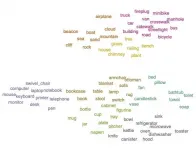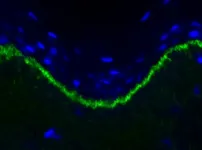Researchers propose a scheme that treats carbon emissions like financial debt
Paying off our carbon debt
2021-07-08
(Press-News.org) The recent extreme heat in the Western United States and Canada may seem remarkable now, but events like these are made more likely, and more severe, under climate change. The consequences are likely to be far-reaching, with overwhelmingly negative impacts on land and ocean ecosystems, biodiversity, food production and the built environment.
"The main lever we have to slow global warming is the rate at which CO2 is added to the atmosphere," said Marcus Thomson, a postdoctoral scholar at the National Center for Ecological Analysis & Synthesis at UC Santa Barbara. Thomson is a co-author of a research article just published in Nature that presents a scheme to slow global warming by tying CO2 emissions to carbon removal obligations.
In spite of several high-profile attempts to limit emissions caused by human activities over the past several decades, atmospheric carbon dioxide has continued to rise steadily. If this trend continues, sufficient CO2 will be added to the atmosphere -- the "remaining carbon budget" will be depleted -- in about a decade to raise the long-term average global temperature by 1.5°C. That in turn raises the likelihood of dangerous and irreversible socioeconomic and ecological damage.
The most recent attempt to cooperatively limit global greenhouse gas emissions was COP21 in 2015, which resulted in the "Paris Agreement", an international treaty that has been in force since. Under the Paris Agreement, individual countries pledge to reduce their emissions in order to keep global warming to no more than +1.5°C and "well below" 2°C. For the Paris Agreement to have any hope of succeeding, and for dangerous global warming to be avoided, it will be necessary to actively remove CO2 from the atmosphere, in addition to limiting emissions. Technically, once the remaining carbon budget is depleted, for every ton of CO2 added to the atmosphere, it will be necessary to remove a ton of CO2 later this century.
In other words, the researchers assert, should emissions continue after the carbon budget is depleted -- which seems likely -- the budget will go negative, and we will begin accruing a carbon debt. The greater this carbon debt grows, the faster and more dramatically the climate will change -- it will become a more difficult problem to fix. This assumption is already baked into the net-zero pledges that countries have made. However, these pledges are still insufficient. There remains no uniform global strategy for national and sub-national governments, public organizations and private companies to get behind to pay down this carbon debt. This raises the risk that future generations will be unfairly burdened with massive debt, and challenges any long-term strategy to limit warming to +1.5°C. In short, in spite of near universal agreement on the need to achieve net-zero emissions, there remains a significant challenge to operationalize concerted action.
Before It's Too Late
In their article, the researchers argue that to assure the viability of a future net-negative carbon economy, funds for future carbon debt repayment ought to be collected through a carbon pricing scheme before and while carbon debt is accrued. As lead author Johannes Bednar, a research scholar at the International Institute for Applied Systems Analysis (IIASA) in Austria and a Ph.D. student at Oxford University explained, "Economic logic dictates that the latest possible time to start doing that is [the moment] when the carbon budget becomes depleted."
In the case of an idealized global emissions trading scheme, emission caps become more stringent as the carbon budget is depleted. For existing schemes, like that used by the European Union, this would mean reducing the quantity of currently scheduled emissions allowances. This risks making the whole scheme economically and politically untenable. The reduced number of allowances would, however, be compensated by Carbon Removal Obligations (CROs), obligating emitters to remove an equivalent quantity of CO2 in the future instead of paying a carbon price now, which may be insufficient to compensate for the eventual cost of warming. In the plan, carbon debt would be managed through CROs which establish legal responsibility for carbon debt repayment.
"We needed a scheme that would be resilient to future interference in its primary goal, which is to decarbonize the environment, yet still be as simple as possible," Thomson said. "CROs work within the existing and foreseeable regulatory environment, and should also be appealing for capital markets. We started with the germ of an idea and worked it through collaboratively. Johannes developed a rigorous proof of concept model, and then pulled everything together beautifully."
Emission trading schemes backed by CROs carry the risk of default by debtors. The authors propose that the latter be addressed by treating carbon debt like financial debt, and by imposing interest on carbon debt. Interest payments would be treated as a rental fee for temporarily storing CO2 in the atmosphere. Additionally, making CROs tradable assets facilitates the de-risking of intertemporal carbon markets.
The proposal resolves some of the inconsistencies in the current academic understanding of scenarios as well as foreseeable failures in climate policy over the long term. Instead of burdening future generations with excessive debt, CROs imply a more equitable distribution of financial flows and costs over time. Moreover, in climate mitigation scenarios, a larger portfolio of CO2 removal technologies usually goes hand in hand with increased carbon debt and therefore a greater reliance on CO2 removal in the future.
"CROs completely change how we see [carbon dioxide removals], from magical tools to enable a 30 year long period of the 'grand atmospheric restoration project' to a technology option that is developed and tested today and flexibly and more incrementally scaled throughout the 21st century and possibly beyond," noted study co-author Michael Obersteiner, director of the Environmental Change Institute (ECI) at Oxford University and a senior research scholar at IIASA.
With CROs in place, carbon debt is penalized through interest payments. Should CROs be rolled out rapidly, the interest on carbon debt would incentivize large-scale near-term CO2 removal on top of conventional emission reductions. This would help to minimize carbon debt and its associated risks, and consequently facilitate a more rapid path to net-zero than scheduled by most countries.
INFORMATION:
ELSE PRESS RELEASES FROM THIS DATE:
2021-07-08
When people see a toothbrush, a car, a tree -- any individual object -- their brain automatically associates it with other things it naturally occurs with, allowing humans to build context for their surroundings and set expectations for the world.
By using machine-learning and brain imaging, researchers measured the extent of the "co-occurrence" phenomenon and identified the brain region involved. The findings appear in Nature Communications.
"When we see a refrigerator, we think we're just looking at a refrigerator, but in our mind, we're also calling up all the other things in a kitchen that we associate with a refrigerator," said corresponding author Mick Bonner, a Johns Hopkins University cognitive scientist. "This is the first time anyone has quantified this and identified ...
2021-07-08
A team of the University of Barcelona has analysed for the first time what the dry and hot periods could be like in the area of the Pyrenees depending on different greenhouse emission scenarios. The results, published in the journal Natural Hazards and Earth System Sciences, show that under an intermediate scenario, where these emissions that accelerate the climate change could be limited, there would not be a rise in long-lasting dry episodes, but temperatures would rise during these periods. On the other hand, if those emissions were not reduced during the 21st century, the summer no-rain periods would last an average ...
2021-07-08
In a new study assessing the potential of a single-dose, intranasal COVID-19 vaccine, a team from the University of Iowa and the University of Georgia found that the vaccine fully protects mice against lethal COVID-19 infection. The vaccine also blocks animal-to-animal transmission of the virus. The findings were published July 2 in the journal Science Advances.
"The currently available vaccines against COVID-19 are very successful, but the majority of the world's population is still unvaccinated and there is a critical need for more vaccines that are easy to use and effective at stopping disease and transmission," says Paul McCray, MD, professor of pediatrics-pulmonary medicine, and microbiology and immunology ...
2021-07-08
Philadelphia, July 8, 2021 - Fifty-five percent of Midwest university students had tried a plant-based meat alternative and attributed this choice to the enjoyment of new food, curiosity about the products, and environmental concern, according to a new study in the Journal of Nutrition Education and Behavior, published by Elsevier.
For several decades, there has been a steady growth in consumer concerns about the environmental sustainability of the global food supply, animal welfare ethics, and human health consequences of red meat intakes. To assess the prevalence of plant-based alternatives to meat consumption in students; describe associations between demographics, environmental concern attitudes, and consumption; ...
2021-07-08
A new study has linked a July 2015 ceasefire of conflict violence in Colombia with better pregnancy outcomes for women who conceived after the ceasefire began. Giancarlo Buitrago of Universidad Nacional de Colombia in Bogotá, Colombia, and Rodrigo Moreno-Serra of the University of York, U.K., present these findings in the open-access journal PLOS Medicine.
Previous research has suggested the possibility that women living in areas with armed violence experience adverse pregnancy outcomes. However, methodological problems or inappropriate data have hampered prior investigations into these associations.
To better understand these associations, Buitrago and Moreno-Serra examined pregnancy outcome data for women who conceived before and after a ceasefire of conflict violence was declared ...
2021-07-08
Scientists at the University of Groningen have trained an Artificial Intelligence system to recognize a specific pattern in skin biopsies of patients with the blistering disease epidermolysis bullosa acquisita. The pattern is characteristic of a specific variant of the disease which can cause scarring of the skin and mucous membranes and may lead to blindness. The new system is easy to use and is better than most doctors in making the diagnosis. A description of this AI system is published in the American Journal of Pathology.
In patients with epidermolysis bullosa, layers of the skin get detached, causing large blisters. There are different forms of blistering diseases affecting different layers ...
2021-07-08
Thyroid hormones are amino acid-based molecules produced by the thyroid gland. Involved in direct or indirect regulation of key metabolic pathways, these molecules play critical roles in the development and normal functioning of the body. The mechanism of how thyroid hormones exert their effect on each other as well as on other metabolic pathways is complex, but a two-way feedback loop is central to their biological activity. Dysregulation of the feedback loop that controls their production affects other biochemical pathways, causing various ailments including those related to the cardiovascular system, liver function, or bone development.
Several clinical studies have shown the effect of thyroid hormones on lipid levels: that treating the patients with thyroid hormone analogs helps ...
2021-07-08
As luck would have it, the air quality sensors that University of Utah researcher Daniel Mendoza and his colleagues installed in Park City, Utah in September 2019, hoping to observe how pollution rose and fell through the ski season and the Sundance Film Festival, captured a far more impactful natural experiment: the COVID-19 pandemic.
Throughout the pandemic, the air sensors watched during lockdowns as air pollution fell in residential and commercial areas, and then as pollution rose again with reopenings. The changing levels, the researchers found, which behaved differently in residential and commercial parts of the city, show where pollution is coming from and how it might change in the future under different policies.
"The lockdown period demonstrated ...
2021-07-08
UNIVERSITY PARK, Pa. -- When it comes to what users share on Twitter, women and users who never attended college voluntarily disclose more personal information than users from other socioeconomic and demographic backgrounds -- potentially making these populations more susceptible to online privacy threats, according to a recent study led by the Penn State College of Information Sciences and Technology.
Additionally, the researchers unexpectedly found that neither socioeconomic status nor demographics is a significant predictor of the use of account security features such as two-factor login authentication, and that users from all backgrounds actually ...
2021-07-08
URBANA, Ill. - If you've ever been to an eye doctor, there's a good chance you've felt the sudden puff of air to the eye that constitutes a traditional test for glaucoma. It's no one's favorite experience, but the puff is non-invasive and harmless.
Scientists use a similar method to test learning and memory in animals and humans. Like Pavlov's classic experiments linking a neutral stimulus with a physiological response, the eyeblink test pairs a light or sound with a quick puff of air to the eye. With repetition, the animal learns to close its eye, or blink, in response ...
LAST 30 PRESS RELEASES:
[Press-News.org] Researchers propose a scheme that treats carbon emissions like financial debt
Paying off our carbon debt



